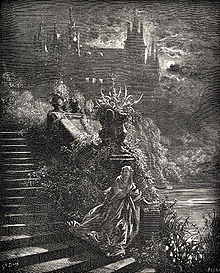Donkeyskin

Donkeyskin (French: Peau d'Âne) is a French literary fairytale written in verse by Charles Perrault. It was first published in 1695 in a small volume and republished in 1697 in Perrault's Histoires ou contes du temps passé.[1] Andrew Lang included it, somewhat euphemized, in The Grey Fairy Book.[2][3] It is classed among folktales of Aarne-Thompson type 510B, unnatural love.
Synopsis[]
A king had a beautiful wife and a rich castle, including a marvelous donkey whose droppings were gold. One day his wife died, after making him promise not to marry except to a woman whose beauty and attributes equaled hers. The king grieved, but was, in time, persuaded to seek another wife. It became clear that the only woman who would fit the promise was his daughter.
She went to her fairy godmother who advised her to make impossible demands as a condition of her consent: a dress as bright as the sun, a dress the colors of the moon, a dress all the colors of the sky, and finally, the hide of his marvelous donkey (which produced gold, and thus was the source of his kingdom's wealth). Such was the king's desire to marry her that he granted all of them. The fairy godmother gave her a marvelous chest to contain all she owned and told her that the donkeyskin would make an excellent disguise.

The princess fled and eventually found a royal farm where they let her work in the kitchen, despite her ugliness in the donkeyskin. On feast days, she would dress herself in the fine gowns her father had given her, and one such day, the prince came by her room and peeped through the keyhole. He fell in love at once, fell ill with his longing, and declared that nothing would cure him but a cake baked by Donkeyskin, and nothing they could say of what a dirty creature she was dissuaded him.
When Donkeyskin baked the cake, her ring fell into it. The prince found it and declared that he would marry only the woman whose finger it fit. Every other woman having failed, he insisted that Donkeyskin try, and it fit her perfectly. When she had dressed herself in her fine gowns, his parents were reconciled with the match. Donkeyskin later found that her father had remarried to a beautiful widow and everyone lived happily ever after.
Retellings and adaptations[]
- Peau d'âne (Donkey Skin) (1970), a French film directed by Jacques Demy and starring Jean Marais and Catherine Deneuve
- Donkey Skin (1976), a translation by Angela Carter for The Fairy Tales of Charles Perrault
- The Donkey's Hide (1982), a Soviet film adaptation.
- Sapsorrow (1988), an episode of Jim Henson's TV series The Storyteller
- Deerskin (1993), a novel by Robin McKinley
- Donkeyskin (1995), a short story by Terri Windling
- Donkeyskin (1995), a poem by Midori Snyder[4]
- The Tale of the Skin (1997), a short story by Emma Donoghue
- Pelzmantel: A Medieval Tale (2003), a novel by K. A. Laity
- Unnatural Issue (2011), a novel by Mercedes Lackey
- The Color Master (2013), a post-modern fairy tale by Aimee Bender detailing the struggle of the dressmakers.
- Riverbed (2017), a short story by Deirdre Sullivan
- "Donkeyskin" or "Faith" is a character in Telltale's game series The Wolf Among Us.
See also[]
- Allerleirauh
- The Goose That Laid the Golden Eggs
- The Wishing-Table, the Gold-Ass, and the Cudgel in the Sack
References[]
- ^ Perrault, Charles. "Donkeyskin". University of Pittsburgh. Retrieved 7 June 2011.
- ^ Lang, Andrew (ed.). "Donkeyskin". The Grey Fairy Book. SurLaLune Fairy Tales. Retrieved 18 May 2020.
- ^ Bottigheimer, Ruth. "Before Contes du temps passe (1697): Charles Perrault's Griselidis, Souhaits and Peau". The Romantic Review, Volume 99, Number 3. pp. 175-189
- ^ Snyder, Midori. "Donkeyskin". Endicott Studio. Archived from the original on 2006-11-11.
Further reading[]
- Goldberg, Christine. "The Donkey Skin Folktale Cycle (AT 510B)". In: The Journal of American Folklore 110, no. 435 (1997): 28-46. doi:10.2307/541584.
- Harf, Laurence. "Le conte de Peau d'Ane dans la littérature du Moyen Age et du XVIe siècle". In: Bulletin de l'Association d'étude sur l'humanisme, la réforme et la renaissance, n°11/1, 1980. La littérature populaire aux XVème et XVIème siècles. Actes du deuxieme colloque de Goutelas (21-23 septembre 1979) pp. 35-42. [DOI: https://doi.org/10.3406/rhren.1980.1164] ; www.persee.fr/doc/rhren_0181-6799_1980_num_11_1_1164
- Jorgensen, Jeana. "Sorting Out Donkey Skin (ATU 510B): Toward an Integrative Literal-Symbolic Analysis of Fairy Tales" In: Cultural Analysis / (2013). Available at https://digitalcommons.butler.edu/facsch_papers/677
- Meyer, Ole. "The First Oral Folk Tale Ever?". In: Fabula 61, no. 3-4 (2020): 316-334. https://doi.org/10.1515/fabula-2020-0017
- Maynard, Rachel L., ""Some Things Grew No Less With Time:" Tracing ATU 510B from the Thirteenth to the Twentieth Century" (2017). Electronic Theses and Dissertations. Paper 3229. https://dc.etsu.edu/etd/3229
External links[]
 Works related to Donkey-skin at Wikisource
Works related to Donkey-skin at Wikisource Media related to Peau d'Âne at Wikimedia Commons
Media related to Peau d'Âne at Wikimedia Commons- Variants
- French fairy tales
- Works by Charles Perrault
- Fictional princesses
- Female characters in fairy tales
- Incest in fiction